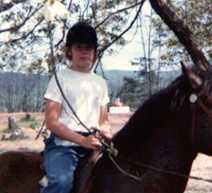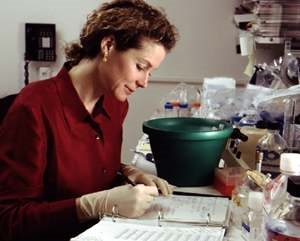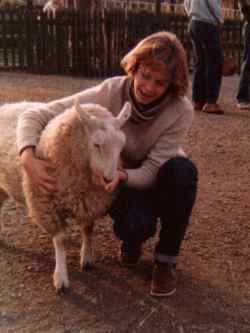 |
| Claudia Gerwin, age 10 |
A childhood passion for horses started Claudia Gerwin on a career path that would ultimately lead to her current position as a scientist at the federal government’s premier neurological research institute.
“I loved riding horses as a kid,” says Gerwin. “I rode all the time and that instilled a love of animals. I really wanted to be a veterinarian.”
So she entered the pre-vet program at Virginia Tech in Blacksburg, Va. “I studied animal sciences and really got turned on by what I was learning,” says Gerwin. “But after four years of college I decided I needed a break.”
After graduating from college, Gerwin worked in the agricultural industry for a few years, and then got a research job at the Medical College of Virginia, in Richmond. “That’s where I really took off,” says Gerwin. “I worked with Dr. Emma Jakoi, who was a wonderful mentor and boss. She was an incredibly clever and gifted scientist who fostered a love of learning and an enthusiasm for science in every individual who worked for her.”
 |
| Claudia Gerwin Neuroscience Research Technician |
When the funding for her position in Jakoi’s lab ran out, Gerwin found her present job at the National Institute of Neurological Disorders and Stroke (NINDS), a part of the National Institutes of Health (NIH) in Bethesda, Md. As a laboratory technician and manager, she conducts experiments and oversees the daily operation of the NINDS Synaptic Function Unit run by Dr. Zu-Hang Sheng.
The overall purpose of the laboratory’s research is to determine how nerve cells relay messages to each other. If a brain cell wants to tell a leg muscle to contract, for example, it does so through a network of interconnected nerve cells. These nerve cells, called neurons, work as sort of a tag relay team to deliver the signal from the brain and to the muscle. Gerwin, Sheng, and their colleagues study the mechanism by which signals pass from one neuron to the next.
“Neurons communicate at specialized junctions called synapses, the process by which neurons exchange information is called synaptic transmission, ” says Gerwin. The neurons don’t quite touch at a synapse, but are separated by a very narrow space called the synaptic cleft. The first neuron—what scientists call the “presynaptic neuron”—releases special chemicals called neurotransmitters into the cleft. The neurotransmitter molecules then cross the gap and act on a second neuron—the “post-synaptic neuron”—that lies on the other side.
 |
| Claudia working in her lab |
The research Gerwin does aims to understand how neurons control neurotransmitter release. Neurons transport neurotransmitters to the synapse in tiny membrane-bound vesicles. These vesicles fuse to the nerve cell membrane at the synaptic terminal, spilling out neurotransmitters into the synaptic cleft. “This vesicle docking and fusion is controlled by a stable complex of proteins, found in virtually all synapses,” says Gerwin. Her lab’s job is to help understand everything about this fusion process, and how it affects synaptic transmission.
All this is pertinent to real life, says Gerwin. “In the big picture, this is important because it will help us understand the normal process of nerve transmission,” she says. “That helps us understand what goes wrong in neurological disorders, such as stroke, epilepsy, or Parkinson’s disease, and to develop new treatments.
 |
| Claudia makes a friend at a zoo in Roanoke, Va. |
Gerwin says her work suits her perfectly, because she is always learning new things. “I like the fact that I can use the expertise I already have, but I am always learning and being stimulated in other ways, whether it is learning a new technique or how to use a new piece of equipment,” she says. “I love my job—the interaction with people, sharing ideas, and working with a wonderful mentor. It really keeps my neurons firing.”
Although you might expect her to go home and watch TV after a long day in the lab, that’s probably the last place you’d find her. She enjoys most outdoor sports, including running, biking, horseback riding, and skiing. She also dances, paints, and does pottery. If you ever do catch her sitting down, she is probably watching some sort of performance art, such as the theater, or listening to live music.
And if Gerwin isn’t participating in some sort of sporting event, she might be organizing one. She has helped organize several athletic fundraisers, such as the DC AIDS Bike Ride and the Avon Breast Cancer Walk. For Gerwin, doing volunteer work is an important part of her life. “I like doing things to help the community and to help people who really need it,” she says. “I like to put my energy toward doing something positive.”
Gerwin doesn’t regret the twists her career path has taken—she never has gotten around to going to veterinary school, for example. “It’s easy to start college thinking that you want to follow a particular career path,” she says. “But along the way, other possibilities open up, and you may find that your career diverges from your original goal. That’s perfectly fine. If you believe in yourself and in your abilities you will find your own niche.”
Page created on 3/10/2006 3:52:36 PM
Last edited 1/9/2017 9:39:31 PM
